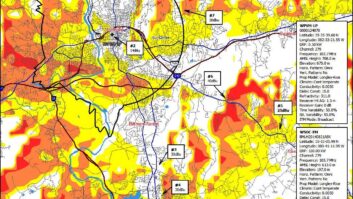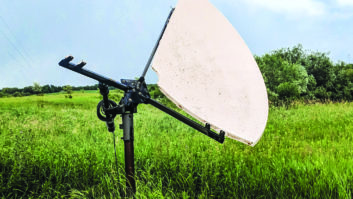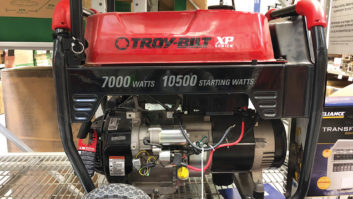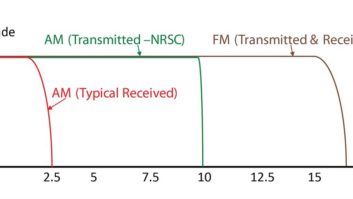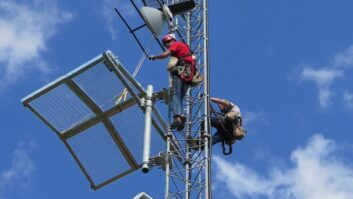Not all transmitter buildings have to be 15 x 20 feet.
(click thumbnail)Fig. 1: No transmitter building is too small for Thermo Bond.
Fig. 1 shows a transmitter “hut” that Thermo Bond Buildings put together for First Broadcasting’s Bert Goldman. With site space at a premium and only a small equipment rack housing the transmitting components, this size was ideal.
Bert adds, “For its size, it’s really spacious inside, especially with the outside, wall-mounted air conditioner.”
Thermo Bond is one of several companies that build such prefabricated structures. If you have a building project coming up, investigate the advantages of a prefab concrete shelter for your next transmitter job.
In addition to strength and deterrence of vandals, advantages include pre-wired electrical, air conditioning, grounding and cable trays – all labor that takes time when you’re stick-building.
Contact Doug Olson at Thermo Bond Buildings, (800) 356-2686 or [email protected]. Be sure to tell him you read about his company in the pages of Workbench.

. . .
I promised another solution for the UPS/generator problem we’ve been discussing. This one is from Russ Jenkins at CKLW in Windsor, Ontario.
Russ writes that about a year ago, he installed a UPS at one of the FM sites he maintains. He quickly discovered the same problem Les Proctor had at his sites. The UPS just didn’t like generator power. Russ’ UPS just would not accept the A/C from the diesel generator.
Russ resolved the problem by plugging the UPS into a Tripp Lite Power Isobar surge suppressor, Model IBAR4ULTRA.The suppressor is plugged into your A/C receptacle. When the diesel is started for a test, the UPS switches so fast it does not even give off the little audible chirp one would hear when the power fails and the UPS goes online.
The Isobar filters the generator A/C sufficiently so the UPS accepts it, as well as giving surge protection. Maybe it will work for you.
Russ Jenkins is chief transmitter engineer for a CHUM Radio group of stations that includes CKLW(AM-FM)/CKWW(AM) and CIMX(FM). Reach him at [email protected].
. . .
Paul Sagi provides engineering consulting services for a group of stations in Kuala Lumpur, Malaysia. He’s been reading RW Online and offers several thoughts to help our readers.
There was mention of using a digital multi-meter instead of a scope to check power supplies. Using a DMM to check ripple on the DC output of power supplies is a good idea, he notes, provided that the DMM AC Volts function reads true RMS.
That’s because ripple in the output of power supplies (especially switchmode supplies) contains a lot of harmonics. Some of the harmonics can be up to 1 MHz, so the frequency response of the meter is an important consideration.
Switch off the auto-ranging of the DMM when making these measurements; the varying input may prevent the meter reading from settling at the proper value.
Switching off the auto-ranging ranging function is also needed when checking transformer winding continuity, especially on big transformers with many turns, e.g. high-voltage transformers; otherwise the meter won’t settle.
(click thumbnail)Fig. 2: Block locks and bolt cutters don’t mix.
Some readers have mentioned problems with people breaking into transmitter sites by cutting padlocks. Fig. 2 shows a photo of a “clamp” and “block lock” that are used on security gates in Malaysia. I’ve seen these b in locksmith stores. They are not invincible but should discourage casual break-ins. The construction of the block lock is such that it is nearly impervious to bolt cutters.
Paul Sagi also liked the idea of IR cameras and IR light sources to catch culprits in the act. Upping the risk of getting caught should discourage vandals. A few years ago, before the price of security cameras came down, an engineer bought a surplus metal, weatherproof camera case. Mounted at the edge of the transmitter building roof and pointing toward the door, the “camera” spooked would-be vandals, and problems dropped dramatically.
Because the inside of the camera case was dark, one couldn’t see if there was a camera inside. A short piece of coax sticking out of the back of the box and disappearing on the roof completed the ruse.

. . .
All of us at one time or another dropped some critical “one-of-a-kind” part on the floor during a repair. Paul Sagi offers a great way to find the small part.
First darken the room; then shine a flashlight parallel to the floor, with the beam just touching the floor. Scan in this way until you see the part, which will stand out (along with any dust bunnies, if the floor was not recently swept).
This works best on smooth floors or short-pile carpets. The method will also work on shag carpeting if the part is atop of the pile, instead of having fallen into it. If the part has fallen into the pile, shine the light downwards at right angles and imagine how the part would look if seen against the background of the carpet, to prime your mind to recognize it.
A strong magnet (for steel parts like O-rings) can help when this method fails.
In my transmitter workshops, I’ve told about using bubble wrap laid in the bottom of the equipment rack or transmitter. Lugs, washers, bolts or other parts that fall are trapped between the “bubbles” and are easier to locate. Several pieces of wrap, folded, make a great seat or kneepad when you’re working in the bottom of a transmitter.
Thanks, Paul, for the advice. He can be reached in Kuala Lumpur at [email protected].
Submissions for this column are encouraged, and qualify for SBE recertification credit.





